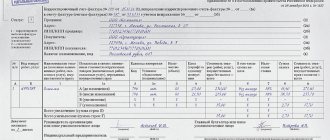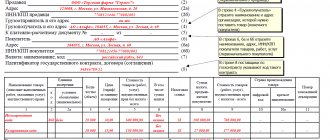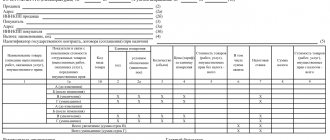Invoice codes are numbers that are assigned to units of measurement, countries, or transactions performed. Necessary to simplify the preparation of invoices, as well as speed up their analysis and verification. Established by various regulations.
There are separate regulations regarding each of the code categories. Violations of their instructions will not be fined. However, it is better to do everything correctly and correct mistakes in a timely manner. Otherwise, you may face demands for clarification from tax authorities or claims from clients.
New invoices from January 1, 2021: sample filling >>
There are several changes in the document.
- In column 7 “Tax rate” you need to indicate new values: instead of the usual rate of 18%, indicate 20% - when selling goods, works or services,
- instead of the estimated rate of 18/118, indicate 20/120, for example, when receiving an advance payment for upcoming deliveries.
We will describe in detail below what to write in the fields of the document.
More than 1,500,000 companies already print invoices, invoices and other documents in the MyWarehouse service Start using
What numbers need to be entered?
The Tax Code regulates the procedure for filling out accounts (Article 169 “Tax Code of the Russian Federation (Part Two)” dated 08/05/2000 No. 117-FZ (as amended on February 19, 2021). For easier formation and verification of accounts/ f, made a specialized list of digital unified codes.
In the form the s/f are used:
- Product.
- Type of operation performed.
- Unit of measurement (relevant when selling goods and services).
- Manufacturer country.
Instructions for filling out an invoice 2021
Filling out the line part
Line 1 Number and date of the invoice. Documents are numbered in order, ascending. Please note that as of October 1, 2021, new rules for storing invoices have been established. Now they should be stored in chronological order - by date of issue or date of receipt. The storage period for invoices and delivery notes has not changed - it is still at least four years from the date of the last entry.
Lines 2, 2a and 2b Name, address, tax identification number and checkpoint of the seller. Be careful! The address from October 1, 2021 is indicated in the invoice according to the Unified State Register of Legal Entities, in detail, without abbreviations (which are acceptable in the constituent documents). Violation of this rule may be grounds for deduction.
Line 3 Information about the sender of the cargo. Indicated only when selling goods. When selling services or performing work, put a dash. If the seller is the sender of the goods, write “He” in this line.
Line 4 Information about the recipient of the cargo. The consignee and his address are indicated in the invoice only when selling goods. If you are submitting a document for services, work, property rights, put a dash.
Line 5 Payment order number - if there was an advance payment (that is, the invoice is drawn up for an advance payment). If not, put a dash. A dash is also placed if prepayment was made on the day of shipment.
Line 6 Name, address (from October 1 - strictly according to the Unified State Register of Legal Entities, without abbreviations), INN and KPP of the buyer.
Line 7 Currency and its code. The invoice is issued in the monetary unit in which prices and payments under the contract are expressed.
Line 8 Government contract number. The government contract identifier has been indicated in invoices since July 1, 2021, and everyone has managed to get used to the innovation. But be careful! Since October 1, 2017, line 8 of the invoice itself has a different name: a clarification has appeared that it is filled out only if data is available. This is what it looks like:
Let us remind you that companies that work with contracts with treasury support are required to indicate in the invoice the number of the government contract (or agreement or agreement on the provision of subsidies, investments, contributions to the authorized capital from the federal budget). They receive a 20-digit code. It is indicated in all contracts drawn up under government orders. You can find this code in the contract or in the Unified Information System. If you do not need to write the IGK on the invoice (that is, you are not working with a contract to which an identifier is assigned), then do not leave the line empty - put a dash in it.
Government Contract ID on Invoices: Sample
Filling out the tabular part of the invoice
Column 1 Name of the product or description of works, services, transferred rights.
Column 1a Here, in the invoice from 10/01/2017, the code of the type of goods is indicated. This applies only to those products that are exported to the EAEU countries.
If you need to indicate a product type code on the invoice, select it from the HS reference book. If not necessary, put a dash.
Column 2 Unit code. The invoice is indicated in accordance with the all-Russian OKEI classifier. The codes in it are in sections 1 and 2.
Column 2a National symbol of the unit of measurement. For example, "pack". You can also check or find out this designation using OKEI.
Column 3 Quantity or volume of goods, works or services. If they cannot be identified, a dash is added.
Column 4 Price per unit of measurement excluding tax. Indicated in the case where it is possible to indicate it, otherwise a dash is placed.
Column 5 Cost of goods, works, services. Indicated excluding tax.
Column 6 Excise tax amount. If you sell non-excisable goods, you cannot put a dash. In this case, write here “No excise duty”.
Column 7 Tax rate.
Column 8 Tax amount in rubles and kopecks - full, without rounding.
Column 9 The cost of the entire quantity or volume of goods, taking into account the amount of tax.
Columns 10 and 10a Country of origin of the goods (in the invoice, both fields are filled in only for imported products). The digital code and short name are indicated here. Both values are given in accordance with the All-Russian Classifier of Countries of the World. Do not write the digital code of Russia in the tenth column of the invoice: filling in is not required for domestically produced goods. In this case, put a dash, as in the next column.
Column 11 Registration number of the customs declaration (indicated in the invoice only for imported goods, in other cases a dash is placed). This column is also new as of October 1, 2021. Previously, the invoice indicated the customs declaration number, but it was serial, but now the registration number is indicated. It looks like this:
What it is?
Invoice codes are a set of unified numbers that are given to units of measurement, countries or transactions performed. They are important for simplifying the creation of invoices, sales books and purchase books, as well as their quick verification.
There are separate Regulations regarding each of the categories of codes . There will be no penalty for spelling errors. But it’s better to fill out everything correctly and correct errors correctly. Otherwise, they may issue a demand with an explanation from the tax authorities or claims from clients.
The codes must comply exactly with the standards. It doesn’t matter whether the legal entity is an LLC or an individual entrepreneur, they will be the same. The main essence of codes is their unification.
Invoice deadline
The procedure for issuing a document has not been affected by changes since January 1, 2021. An invoice is issued within 5 days from the moment of: a) shipment of goods, performance of work, provision of services, transfer of rights, or b) receipt of advance payment. Calendar days are counted.
The period is counted from the day following the day of shipment or receipt of advance payment. If the last day of the term falls on a non-working day, the expiration date of the term is considered to be the nearest next working day.
According to the law, there is no penalty for missing the deadline for submitting an invoice. An organization can be fined only for the absence of a document. However, a violated procedure for issuing invoices at the junction of tax periods can still lead to a fine. Thus, late provision of a document may be considered as its absence. For example, when an organization issues an invoice at the beginning of the current tax period that should have been issued at the end of the previous one.
Do I need to correct errors in codes?
The state does not provide for penalties for errors in specifying codes. Corrections make sense in the following cases:
- The buyer filed a claim, citing incorrect filling out of documents and the resulting problems with the Tax authorities.
- The company received a request for clarification from the Federal Tax Service.
If these factors are absent, the issue of the need to correct the code is decided by the organization itself. As a rule, correcting the designation in primary documents is quite simple. The difficulty arises because there is also an invoice that has already been sent to the buyer.
In most cases, if an error is not detected in a timely manner, it may not be corrected. If the Tax Service and buyers have not made any claims, the violation will not bring negative consequences. However, you need to remember that the codes refer to mandatory items on the invoice. This means that violations in them are usually detected. Therefore, you need to be careful when filling out documents.
Fill out an invoice in a few minutes
MyWarehouse is a convenient program for printing invoices and other documents. Thanks to the intuitive interface of MyWarehouse, creating an invoice takes no more than a minute. Each step in drawing up a document is transparent to the user and is accompanied by clear comments.
Advantages of working with documents in the MoySklad service:
- saving 70% of time on preparing an invoice using a new form;
- no errors when entering data;
- automatic generation of an archive of printed documents;
- automatic continuous numbering of documents;
- output forms to Excel and PDF format.
How to find out and indicate the registration number of the customs declaration
The registration number of the customs declaration is a specific reporting codifier indicating information about the customs authority, the date of receipt and the serial number of the reporting form. Rules of application and decoding of the code according to the latest clarifications of controllers.
Back in October 2021, officials adjusted the rules for compiling documentation used in calculating value added tax. Among the numerous changes in the structure and content of the forms, a new requisite has been introduced - the registration number of the customs declaration (in the invoice, purchase and sales books).
Structure and rules of application
The updated cipher is 21 characters long. Essentially, the code consists of three groups of numbers:
- the first group is 8 digits indicating the code of the customs authority in which the declaration documentation was registered;
- the second group is 6 digits that disclose information about the date of registration of the report at the customs office;
- the third is the last 7 numbers indicating the serial numbering of the declaration report.
Externally, the cipher looks like this:
| First group | Second group | Third group |
| XXXXXXXXX/ | XXXXXXX/ | XXXXXXXXX |
Please note that the registration number of the customs declaration in the book of sales, purchases or invoice is indicated according to uniform standards. That is, groups of numbers indicating specific code information are separated by a fraction (slash).
Cipher examples
| First group | Second group | Third group |
| 10714040/ | 110919/ | 0095741 |
| The declaration documentation was accepted by the customs post "Vostochny Sea Port of Nakhodka Customs" | Report submission date: September 11, 2021 | The serial numbering assigned to the documentation is 0095741. |
In the report, the code looks like this: 10714040/110919/0095741. Moreover, groups are separated only by a slash; no spaces, dots or other characters are provided.
Customs codes of other countries may be different. For example, in Armenia the customs authority code is only two digits. In Belarus there are only 5 characters, as in Kazakhstan and Kyrgyzstan.
Where to get the code
We figured out the structure and rules for writing code. But actually, where can I get the registration number of the customs declaration? This code is indicated in the first line of column A of the main sheet of the declaration. The code is also duplicated on the first line of column A of the additional sheet of declaration documentation.
The example shows where the customs declaration number is in the declaration.
Difference from old props
The details are not completely new for the documentation used in calculating VAT. Previously, the declaration registration number was used in reporting in a similar manner.
Only the name of the codifier was slightly different. Before the changes on 10/01/2017, the code was referred to as “customs declaration number”.
Now the documentation details have been changed, the word “number” has been supplemented with the definition “registration”.
The positions where it was possible to check the registration number of the customs declaration have not changed. These are the same first lines of column A of the declaration document. Details should be indicated:
- column 11 of the invoice;
- column 3a of the sales book;
- column 13 of the purchase book.
Indicate the TD number in the alcohol declaration according to the general rules. That is, enter the code using a fraction, without spaces. If there are several ciphers, specify them all separated by a semicolon.
Filling Features
For each type of document there is a special procedure for drawing up. All rules are enshrined in Decree of the Government of the Russian Federation No. 1137 (as amended).
On the invoice
Fill in the details in the invoice in two cases:
- If the goods for which documentation is being prepared do not originate in Russia.
- If goods are released for domestic consumption, at the end of the free customs zone of the Kaliningrad region.
In the shopping book
Indicate the registration number of the customs declaration in the purchase book for goods imported into the territory of the Russian Federation. Provided that their declaration through customs is provided for by EEC regulations.
Enter the registration number in the appropriate box. Or list all TD registration codes in which the imported goods were registered. Enter codes separated by semicolons, in accordance with the design rules.
In the sales book
Indicate the details in a separate column 3a of the sales book. Fill out the TD registration number when releasing products for domestic consumption upon completion of the free customs zone of Kaliningrad and the region.
Fill in the details when selling goods for which VAT is calculated when declaring through customs:
- was not paid, in accordance with paragraph. 1 sub. 1.1 clause 1 art. 151 Tax Code of the Russian Federation;
- paid in accordance with paragraph. 3 subp. 1.1 clause 1 art. 151 Tax Code of the Russian Federation.
Source: https://ppt.ru/forms/tamoj/registratsionnyy-nomer-tamozhennoy-deklaratsii






